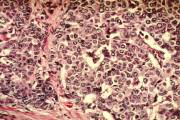 The recent finding of decreasing breast cancer rates made headlines throughout the media; including a NY Times article entitled, Reversing Trend, Big Drop is seen in Breast Cancer on December 15, 2006.
The recent finding of decreasing breast cancer rates made headlines throughout the media; including a NY Times article entitled, Reversing Trend, Big Drop is seen in Breast Cancer on December 15, 2006.
Striking epidemiological facts tells us that breast cancer is the most common cancer in women in the U.S., and only second to lung cancer as the most common cause of cancer deaths. It is estimated that approximately 212,920 American women will be diagnosed with breast cancer in the year 2006, and 40,970 women will die from this disease. (1) The unfortunate truth is that during a woman’s life, she has a one in six chance of developing breast cancer. Between 1940 and 1980 breast cancer rates rose 1.2% per year. The more pronounced increase in early stage breast cancers during the 1980s was probably due to the use of screening mammography. Since 1987, there have been no significant changes. Over recent years, we’ve seen that there has been a trend towards increased estrogen receptor/progesterone receptor (er/pr) positive disease and a decrease towards ER/PR negative disease.
It was in July 2002, the Women’s Health Initiative (WHI) Study changed standard practice regarding hormone replacement therapy. The estrogen plus progestin component of the WHI Study was a randomized controlled primary prevention trial which enrolled 16,608 post-menopausal women ages 50-79 during 1993-1998. Women received estrogen + progesterone or placebo. The primary outcome was coronary heart disease, with invasive breast cancer as the primary adverse outcome. In May, 2002, the trial of estrogen + progesterone was ended early due to an increased risk of breast cancer, CHD, stroke, and venous thromboembolism over 5.2 years. The study did report a reduction in risk of fractures and colon cancer; nonetheless, the risks obviously outweighed the benefits for many women. In December 2006, a group from MD Anderson reported a sharp decrease in breast cancer incidence in the United States in 2003. Using data from the Surveillance, Epidemiology, and End Results (SEER) program of the National Cancer Institute they were able to draw certain epidemiological conclusions regarding the incidence of breast cancer. The statistics were quite impressive. In their abstract (2), Dr. Ravdin et al. report the following:
- From 1990-1998, breast cancer incidence rose at 1.7% per year
- Between 1998-2003, incidence began to increase at 1% per year.
- In 2003, there was a 7% decrease within a single year.
- The decline was most evident in patients older than 50.
- The decline in incidence in ER positive invasive tumors was greater than ER negative tumors. (8% vs 4%)
- When the analysis was restricted to patients 50-69 years of age, this difference in decline by ER was more striking. (12% vs 4%)
The group believes that the decreased use of hormone replacement therapy can possibly explain the decreased breast cancer rates. Other factors that were analyzed included less mammography screening, increased use of tamoxifen and increased statin use. The most striking decrease in breast cancer rates were seen in 2003. This trend nicely correlated with the decreased hormone replacement use.
Although more studies may be necessary to draw official conclusions, this is ground-breaking news. It may provide us with more insight into the patho-physiology of estrogen/progesterone responsive tumors and may even play a major role in future prevention and management.
1 Jemal A. et al. Cancer statistics, 2006. CA Cancer J Clin. 2006 Mar-Apr;56(2):106-30.
2 Abstract Presented at 29th Annual San Antonio Breast Cancer Symposium
Image: histologic slide of breast cancer cells that have grown out the ducts and into the surrounding tissue displacing normal cells. Stained with H&E and magnified to 200x. Courtesy NCI Visuals Online
